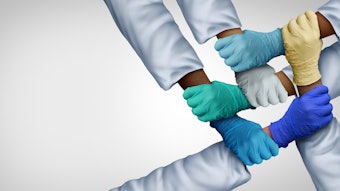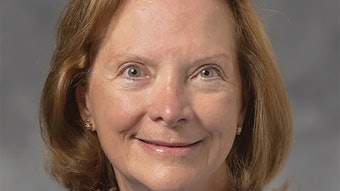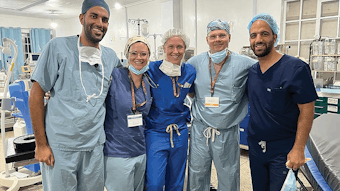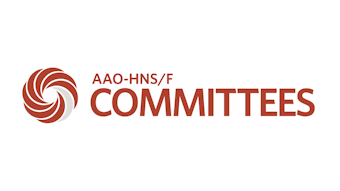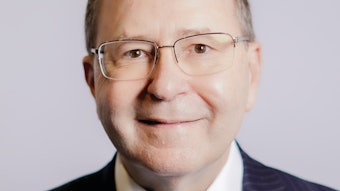FROM THE EDUCATION COMMITTEES: Gender-Affirming Care Provided by the Otolaryngologist
Any care that is sensitive, responsive, and affirming to a person’s gender identity and expression is gender affirming. The single most important thing that anyone can do to provide gender-affirming care is to simply treat people with respect and dignity.
Laura Garcia-Rodriguez, MD, member of the Facial Plastic and Reconstructive Surgery Education Committee, and AJ Flaherty, MD

Although Western civilization and, by extension, Western medicine, have long centered the experiences of heterosexual White men as the norm,1 society’s more recent shift toward acceptance and understanding of diverse populations has introduced paradigms that can seem unprecedented and are therefore experienced as new or unusual. However, applying an intersectional, cross-cultural, and historical lens to concepts such as sexual and gender diversity reveals that, similar to how today’s concept of “race” was developed by the United States,2 Western imperialism created a colonial concept of a “gender binary” that excludes the experience of people who have existed outside this dichotomy for the entirety of known history.3 Examples of such “third gender” classifications include the Hijra of India and Bangladesh, Fa’afafine of Samoa, Two-Spirit of Native America, Māhū of Hawaiʻi and Tahiti, Xanith of Oman, Travesti of Brazil, and Bissu and Waria of Indonesia.4 Meanwhile, newer terms such as transgender and nonbinary, along with separate definitions for the social constructs of sex and gender, have developed in an effort to understand the existence of “third gender” people through the lens of the gender binary.
A recent survey found that 5.1% of U.S. adults under the age of 30 identify as transgender or nonbinary.5 As our society becomes more accepting of diverse populations, the percentage of openly gender-diverse people will continue to increase. Today’s clinician will benefit from an understanding of the history of gender diversity, the ability to use appropriate terminology, and insight into how sociopolitical influences result in concepts like the gender binary and affect our ability to provide gender-affirming care. Otolaryngologists are uniquely positioned to provide gender-affirming care specific to the face and voice thanks to our subspecialized training involving these characteristics so commonly used to categorize people by their gender.6 Despite this, significant educational and training gaps exist, limiting our ability to provide such care.7,8 Furthermore, gender-diverse patients suffer from the same medical conditions as gender normative patients—e.g., head and neck cancer, sinus disease, chronic ear disease, salivary gland disease—yet their gender identity can complicate and even prevent adequate treatment when it (instead of the actual condition) is inappropriately focused upon by the medical provider.9 As an otolaryngologist and facial plastic surgeon who performs gender-affirming surgeries, Dr. Garcia-Rodriguez often receives referrals for patients with ear pain, simply because they are transgender. Although such a patient would benefit more from evaluation by a comprehensive otolaryngologist, otologist, or neurotologist, scheduling mishaps or sometimes even the patient request for a “trans friendly” physician can result in this inappropriate use of resources and delay in appropriate care.
Our hope is that all otolaryngologists and physicians in general can someday be thought of as trans friendly—there is no room for prejudice of any kind in our profession. Gender affirmation is a social process of being recognized in one’s identity and critical to the health and well-being of gender-diverse people.10 It can be tempting to think that gender-affirming care is limited to specific interventions, such as counseling, hormone therapy, voice therapy, and surgery. However, any care that is sensitive, responsive, and affirming to a person’s gender identity and expression is gender affirming. The single most important thing that anyone can do to provide gender-affirming care is to simply treat people with respect and dignity. This involves using (and documenting, where needed) the appropriate pronoun and name and avoiding misgendering (using the wrong pronoun or name, one of the most common microaggressions experienced by gender-diverse people). If you are not sure about what name or pronoun to use, start with gender-neutral language and ask politely.
Concepts such as gender diversity can be confusing and difficult to understand from the rigid perspective of the gender binary. We believe that insight into the long history of gender diversity across cultures, along with continued scientific advancements revealing that biological sex exists on a spectrum rather than a binary, can help shift the perspective to one of understanding and respect for all persons. We have provided a list of terminology and definitions for use as a starting point and encourage our colleagues to continue seeking information and education about how best we can serve our gender-diverse patients.
Terminology for Gender-Affirming Care
Sex: category into which humans and most other living things are divided on the basis of their reproductive functions
- Evolved from the Latin “sexus,” meaning the quality of being male or female
- Determined by a combination of characteristics including chromosomes, hormones, internal and external reproductive organs, and secondary sex characteristics
- Assigned at birth based on the appearance of a newborn’s external anatomy (genitals)
Gender: another word for “sex” but now used more commonly in reference to social and cultural differences rather than biological ones
- Evolved from the Latin “genus,” meaning kind, sort, or class
- Define “sex” as biological and “gender” as psychological or psychosocial in an effort by some to separate sex from gender and validate transgender identities
Gender binary: classification system consisting of only two genders, male and female; associated with belief that one’s sex as assigned at birth must align with traditional social constructs of masculine and feminine identity, expression, and sexuality
Cisgender (“cis” for short): a person who identifies with the gender they were assigned at birth
Transgender (“trans” for short): a person whose gender identity, expression, or behavior does not conform to what is typically associated with their assigned sex at birth
- Nota bene: “Transgender” is an adjective, making use of “transgender people” is appropriate, but use of “transgenders” or “transgendered” is disrespectful and offensive.
- Nota bene: “Transsexual” is an older term that originated in the medical and psychological communities and therefore it may still be seen in the literature, although it has fallen out of favor. It is not an umbrella term as is “transgender.” When used, it refers to a trans person who has taken medical steps to physically transition from the gender they were assigned at birth. You should not use this term unless someone specifically asks you to use it in reference to them.
Trans(gender) woman: a person who was assigned male at birth but identifies as female
Trans(gender) man: a person who was assigned female at birth but identifies as male
Nonbinary: a person who does not identify with either male or female sex/gender classifications
Gender identity: internal, deeply held sense of gender; not visible to others
Sexual orientation: a person’s physical, romantic, and emotional attraction to other people
Gender expression: a term encompassing the external manifestations of gender that are visible to others; can include a person's name, pronouns, clothing, haircut, behavior, voice, and/or body characteristics
Gender dysphoria: state of unease or general dissatisfaction with life, resulting from a discrepancy between one’s gender identity and the sex one was assigned at birth
- This state is often related directly to how society interprets/assumes sex/gender based on appearance and physical characteristics and the resultant treatment of people who do not conform to “norms.”
- According to the American Psychiatric Association, “gender nonconformity is not in itself a mental disorder. The critical element of gender dysphoria is the presence of clinically significant distress associated with the condition.”11
Gender affirmation: any care that is sensitive, responsive, and affirming to a person’s gender identity and/or expression.
- Healthcare that holistically attends to transgender people’s physical, mental, and social health needs and well-being while respectfully affirming their gender identity
Misgendering: using the wrong pronoun or name; one of the most common microaggressions experienced by gender-diverse people

